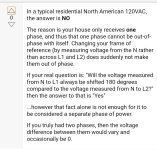Of course, the original question had to do with using two legs of a three phase generator to produce 220/240 volt for home use.
Oh the complexity!
It's been long but related to the tail end of the original posts questions.
Why is a 110v/220v generator called single phasea nd not 2 phase? It provides 2 phases of electricity capable of generating 220v? They're definitely distinct from generators that only provide single phase 110v.

